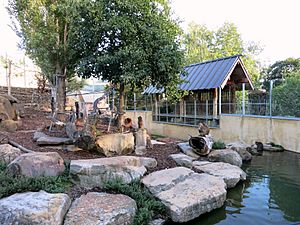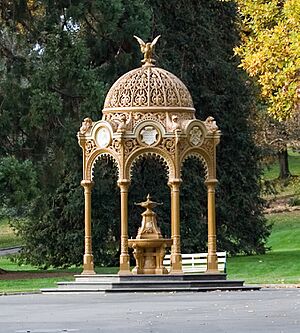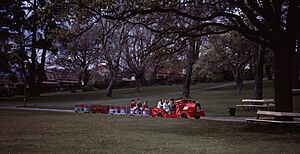City Park, Launceston facts for kids
Launceston City Park is a beautiful park located in Launceston, Tasmania, Australia. It was first started in the 1820s by a group called the Launceston Horticultural Society. Later, in 1863, it was given to the Launceston City Council. Today, it's a very important place for culture and history in Launceston.
History of the Park
The story of City Park began in 1807 with a piece of land set aside for a government house. In the 1820s, the Launceston Horticultural Society got the land next to it. They used this area as a special garden for plants.
In 1863, the Horticultural Society gave their gardens to the Launceston City Council. They combined these with the government gardens to create what was called 'Peoples Park'. Over time, the old government house became run down. It was also given to the council in 1885 and then taken down.
In 1891, a large building called the Albert Hall was built at one corner of the park. This was for the Tasmanian Industrial Exhibition. A big part of the park was covered with temporary buildings for this event. There was even a small train that ran through the park for a short time during the exhibition.
Later, in 1932, the Launceston Corporation built the John Hart Conservatory. This is a special glasshouse for plants. A second, identical conservatory was also built in another town called Parramatta Creek.
In 1965, Launceston became a "sister city" with Ikeda City in Japan. As a special gift, Ikeda City gave Launceston a group of Japanese macaque monkeys. An enclosure was built for them near the Cameron Street entrance to the park.
What You Can See and Do
City Park has many fun things to see and do. You can explore beautiful gardens and visit the conservatory. There's also a band stand, a duck pond, and a playground for kids.
One of the most popular spots is Monkey Island. This is home to a group of macaques. You can watch them through a glass wall, separated by a small moat.
The park also has several memorials and statues. These include Launceston's Boer War Memorial and a statue of a famous botanist named Ronald Campbell Gunn. There's even a cannon taken as a prize from the Crimean War.
The biggest building in the park is the Albert Hall. Next to it are the studios for City Park Radio. These are in the old Park Caretaker's Cottage. This cottage also has one of Australia's oldest wisteria vines, planted way back in 1837.
Every February, the park hosts Festivale. This is a popular yearly food festival.
Since 1960, different trains have given rides around the park paths. The first train was built in 1960 and was called Little Toot. It had an engine and four brightly colored carriages.




